Museums in Puglia
Our guide to museums in Puglia – helping to bring to life the history and culture tucked in Italy’s heel.
Puglia’s museums are plentiful – not surprising for an area steeped in such rich history. What’s more, museums in Puglia also reflect some of the wonderful customs and traditions which have made us so fond of this stunning corner of southern Italy. In fact, there are so many museums scattered around Puglia that we could never hope to provide an exhaustive list of those to visit during your holiday. However, we hope that this at least gives you information on some of the most easily accessible museums, in the region’s principal towns. And we hope it provides a helpful starting point to your holiday planning.
Alberobello
In Alberobello, it’s definitely worth taking the time to visit the town’s largest trullo – Trullo Sovrano. This is a unique two storey trullo housing a fascinating museum, showing what life in a trullo was like. Arguably, it’s one of the most immersive museums in Puglia and offers a unique glimpse into life in the past in rural Puglia. Having been built in the 18th century for a wealthy priest and his family, inside visitors will find original furnishings and kitchen utensils. However, what makes this particular trullo so special is the stone staircase – a rare addition as trulli are traditionally single story.

The best way to experience Trullo Sovrano is to join a small group or private tour with a local guide. Not only do they have a wealth of knowledge, we always find the witty and entertaining delivery most engaging. Book your tour in advance here.
Also in Aberobello is the Museo dell Territorio – Casa Pezzolla. Similar in concept to Trullo Sovrano and well worth adding to your list if you have a little more time.
Discover our full guide to Alberobello here.
Lecce
When thinking about museums in Puglia, Lecce certainly has its fair share. The city is rich is history and boast some of the finest Baroque architecture in Europe. Simply being in Lecce can feel like a museum trip however for the real deal, these are our highlights:
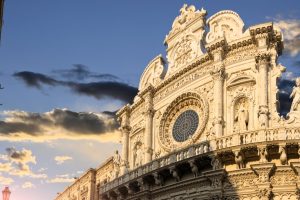
Provincial Archaeological Museum of San Castromediano
Although its situated just outside the main historic centre of the city, this is actually the oldest public museum in the region. Inside visitors will discover a window into Messapian, Roman and early Christian times. Highlights include a collection of Messapian tombs, Roman statues and ceramics. On the upper floor there is a display of early Christina artwork. A real bonus to this museum in Puglia is that it’s free to enter.
Lecce Historic Museum
This museum aims to chart the history of Lecce. With entry costing just a few euros, it’s definitely worth popping in to this museum in Puglia. One of the highlights is the immersive 3D video experience. These short films vividly reconstruct ancient Lecce — known in Roman times as Lupiae. They cleverly transport visitors through centuries of architectural and cultural change. After wandering around modern-day Lecce, these cutting-edge animations allow you to visualize long-lost monuments and see how the city has evolved over time.
Archaeological Museum Faggiano
Not your average museum in Puglia – this is actually a family home. However in 2001,when the family began some renovations to modernise the pipework, they lifted the floorboards and discovered a whole world or worlds beneath. The ensuing 7 year excavation period uncovered 2,500 years of history. Visitors can see a granary, cisterns, frescos, underground escape ways, a well and hypogeum. Another immersive experience and well worth the small entry fee.
Museum of the Roman Theatre
The Roman Theatre of Lecce was only uncovered in the 20th century having been buried for centuries beneath layers of medieval and modern construction. Although it’s not as grand as other Roman amphitheatres, its compact beauty and historical richness make it a well worth a visit.
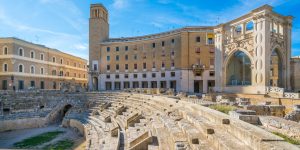
Beyond the amphitheatre itself, at the museum, there are models, artifacts, and multimedia exhibits. These tell the story of the theatre’s construction and use during the 1st and 2nd centuries AD. In its heyday, the theatre could seat around 5,000 spectators and was used for dramatic performances, poetry readings, and religious festivals.
Looking for more information about Lecce? Read our full city guide here.
Taranto
The archaeological theme continues in Taranto. Home to Il Museo Archeologico Nazionale di Taranto which covers a vast period of history including Pre-History and Proto-History, the Greek and Roman periods as well as Late Antiquity and the Middle Ages. Although it’s not very well known, this museum in Puglia is one of the most important in Italy. However, it is rarely on a tourist’s itinerary.
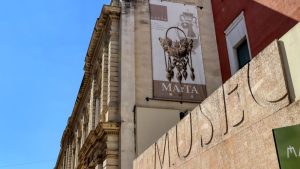
Once the powerful Greek colony of Taras, Taranto was central in the world of Magna Graecia. The museum showcases this heritage through a dazzling display of art and everyday life — from prehistoric times and through to the Roman empire. Undoubtably the star attraction in this museum in Puglia is the Ori di Taranto (gold of Taranto). A breathtaking collection of intricately crafted gold jewellery and marvellous showcase of the skill and sophistication of ancient times.
Altamura
The Museo Archeologico in Altamura houses a collection of grave goods dating back to the 8th to 5th century BC as well as a collection of local ceramics. However, the most famous of its exhibits is without doubt, the Man of Altamura. A skeleton of an adult male whose skeleton has features of Neanderthal man and forms of the Homus Erectus. This museum in Puglia has a wonderful local community focus and regularly hosts events and workshops for locals and tourists to enjoy together.
Monopoli
Typically, tourists visit Monopoli for its stunning beaches and coastline. However, behind the iconic white-washed old town and vibrant harbour, Monopoli’s history is just as fascinating as so much of this magnificent region in southern Italy. The The Municipal Archaeological Museum of Monopoli is housed in the Castle of Charles V within the old town. Taking visitors on a journey back in time, it houses prehistoric, Greek and Messapian artifacts. But also be sure to see the Roman amphorae and mosaics.
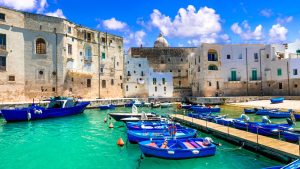
One of our favourite things about this museum in Puglia is how it presents ancient artifacts along side modern technology. Interactive displays and digital reconstructions allow visitors to visualize Monopoli’s transformation over centuries. From a Bronze Age village to a fortified medieval port.
Egnazia
For those interested in archaeology, it’s also worth heading to Egnazia. The site is home to ruins from the Messapian and Roman periods and also boasts an on site museum displaying some remarkable excavated artefacts – including mosaics and pottery. (Open April to September)
For a more gruesome snapshot of time gone past, spend an hour at the Castello di Peschici. Brace for displays exhibiting various methods of torture used over the centuries.
Fasano
For those with more of an interest in food than history, then the Museo dell’ Olio d’Oliva in Fasano is worth a visit. The museum is housed in the 17th Century Masseria Sant ‘Angelo de Graecis. A visit here allows you the opportunity to learn about the traditional processes by which the Italians make olive oil, as well as the history of the product. It’s a chance to find out what you always wanted to know about Italian olive oil!

Ostuni
Although not strictly a museum, there is another opportunity to learn about olive oil in Ostuni. At the Masseria Brancati the owners of this ancient masseria will take you on a tour around the olive groves and explain the ancient methods of producing olive oil. You’ll also get the chance to taste the fruits of the labour of some of their more recent oil production.
Looking for somewhere to stay in Ostuni? Discover our collection of stunning villas and apartments in the area here.
Andria
For those who prefer sweet to savoury, and for younger visitors, head to the Museo del Confetto Mucci Giovanni, a museum and shop shedding light on the process of making sweets. Founded in 1894, Mucci Giovanni is one of Italy’s most beloved confectionery brands. It’s known internationally for its confetti — sugar-coated almonds – traditionally given at weddings and celebrations. The museum is located inside the company’s original production site – a charming art nouveau building in Andria’s historic centre.

Open between 8.30 and 13.00 and 17.00 – 21.00 Monday to Friday and then from 10.00 until 13.00 on Sundays, entry costs just a few euros. From the moment you step through the doors, you’ll be transported into a world where passion, precision, and tradition have been preserved for over a century.
Manduria
But let’s not forget the wine. Just as important in Puglian culture as it’s food. The Museo del Primitivo informs visitors about the rural culture of Salento and the wine production of the region. This rather unique museum in Puglia is a place where the scent of oak barrels fills the air and every room tells the story of a wine that has become a symbol of the region.
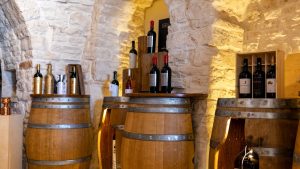
However, no visit to the Museo del Primitivo is complete without an almost mandatory tasting. After exploring the cellars, visitors are invited to sample a variety of Primitivo wines — from classic reds to fortified Primitivo di Manduria Dolce Naturale – Italy’s first DOCG wine in the region. Expert sommeliers guide you through the flavours, aromas, and characteristics that make this grape variety so unique.
Castellaneta
Finally, for something completely different – this time a museum in Puglia for fans of film. Dedicated to one of the most iconic figures of early Hollywood, this museum honours the life and legacy of Rodolfo Valentino – local man and silent film superstar.
Perfect for film buffs, history lovers, or anyone curious about the golden age of cinema. A visit to Museo Rodolfo Valentino offers an intimate portrait of a man who captured the world’s imagination. And almost more importantly, whose roots trace back to this rather sleepy southern Italian town.

We hope you have found this guide to museums in Puglia useful. Looking for accommodation for your trip to Puglia? Discover our full collection of stunning villas and apartments in Puglia here. From traditional trulli to luxury beach villas – we have something for everyone. Or contact us at Bookings For You to help us find your perfect place in Puglia.



